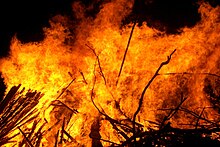Fire
This article needs more sources for reliability. |



Fire is a chemical reaction that gives off light and heat. Fire happens when a material rapidly oxidizes, or loses electrons, and releases a great amount of energy. Flames are only the portion of the fire that gives off visible light.
Fire is sometimes useful, but also very dangerous because it can cause houses, trees and other things to burn to ashes. Forest fires are very harmful. They can destroy a huge area in a matter of minutes. Every year people die by accidents from fire.
Fire can be started by heating a material in many different ways. Once the material is heated past a temperature called the ignition point, it will start to burn, beginning a fire. Some common ways to start a fire include rubbing sticks together very rapidly, making sparks by hitting flint with steel, or using matches or a lighter. The Sun does not make fire. Instead, it crushes together hydrogen atoms to release energy through a process called nuclear fusion.
Uses
[change | change source]Fire can be very useful if it is treated carefully. It has always been very important for people to be able to make fire. People need its heat to keep warm on cold days. It is also used to cook meats. Its light helped people see in dark places and scare away predators.
Most heat engines work by fire.
Danger
[change | change source]If human skin touches fire, the skin may burn, which can take some time to heal and to remove the scar. If a fire gives off a large amount of smoke, a person's mouth should be covered with a wet cloth, since people can faint when they breathe in too much smoke. Even a spark, such as from a cigarette, should be kept away from any fuels that very easily catch and spread fire, like gasoline, or cause an explosion, like gunpowder.
If fire is not treated carefully, it can be very dangerous. One wildfire sometimes burns thousands of square miles or kilometers. Forests can burn down if fires are not controlled. Every year, large areas of forests are destroyed because of fire. This usually happens in the summer.
Controlling
[change | change source]In some camps, there is a camp fire; around the camp fire, there are usually some rocks to stop it from spreading. In buildings, fire shutters can be used.[1] Fire shutters contain a fire. With the help of effective shutters, a fire cannot spread from room to room in a building.
Fire needs three things to burn: oxygen, fuel, and heat. Fuels can be wood, tinder, coal, oil, or any other substance that will easily oxidize. Once a fire is burning, it creates its own heat. This lets the fire keep burning on its own for some time.
Firefighters are people with special training to control and stop fires. They also rescue victims of fire related incidents.
A fire can be stopped in three different ways:
- The fuel can be removed. If a fire burns through all of its fuel and extra nearby fuel is removed, the fire will stop burning.
- The oxygen can be removed. This is called "smothering" a fire. Fires cannot burn in a vacuum or if they are covered in carbon dioxide.

An Indoor fireplace protects the home from the fire that heats it - The heat can be removed. The most common way to remove heat is to use water to absorb that heat, putting the fire out.
However, some fires cannot be smothered, such as magnesium flames. They can burn in carbon dioxide, nitrogen, and some other elemental compounds. However, they cannot burn in noble gases such as helium.
Reactions
[change | change source]Fires are usually combustion reactions that take carbon, hydrogen, and oxygen.[2] The products are commonly water and carbon dioxide, although there are other examples that avoid this generalization, such as burning magnesium in air, which makes magnesium oxide. Fires can occur in many ways. There are many types of fire. There are wood fires, gas fires, metal fires, and more.
Wood fires can usually be put out with water because water absorbs heat, but metal fires are too hot for water to absorb enough heat to put out the fire. If water is used to extinguish ("put out") a metal fire, the water will simply evaporate. For metal fires, sand can be used to cover the fire and keep it from obtaining oxygen. A fire extinguisher can put out most fires.
Related pages
[change | change source]References
[change | change source]- ↑ "Fire shutters during a fire". Fire Shutters. Archived from the original on 2021-08-04. Retrieved 2020-10-30.
- ↑ "Complete combustion - an overview | ScienceDirect Topics". www.sciencedirect.com. Archived from the original on 2020-11-11. Retrieved 2020-10-30.

